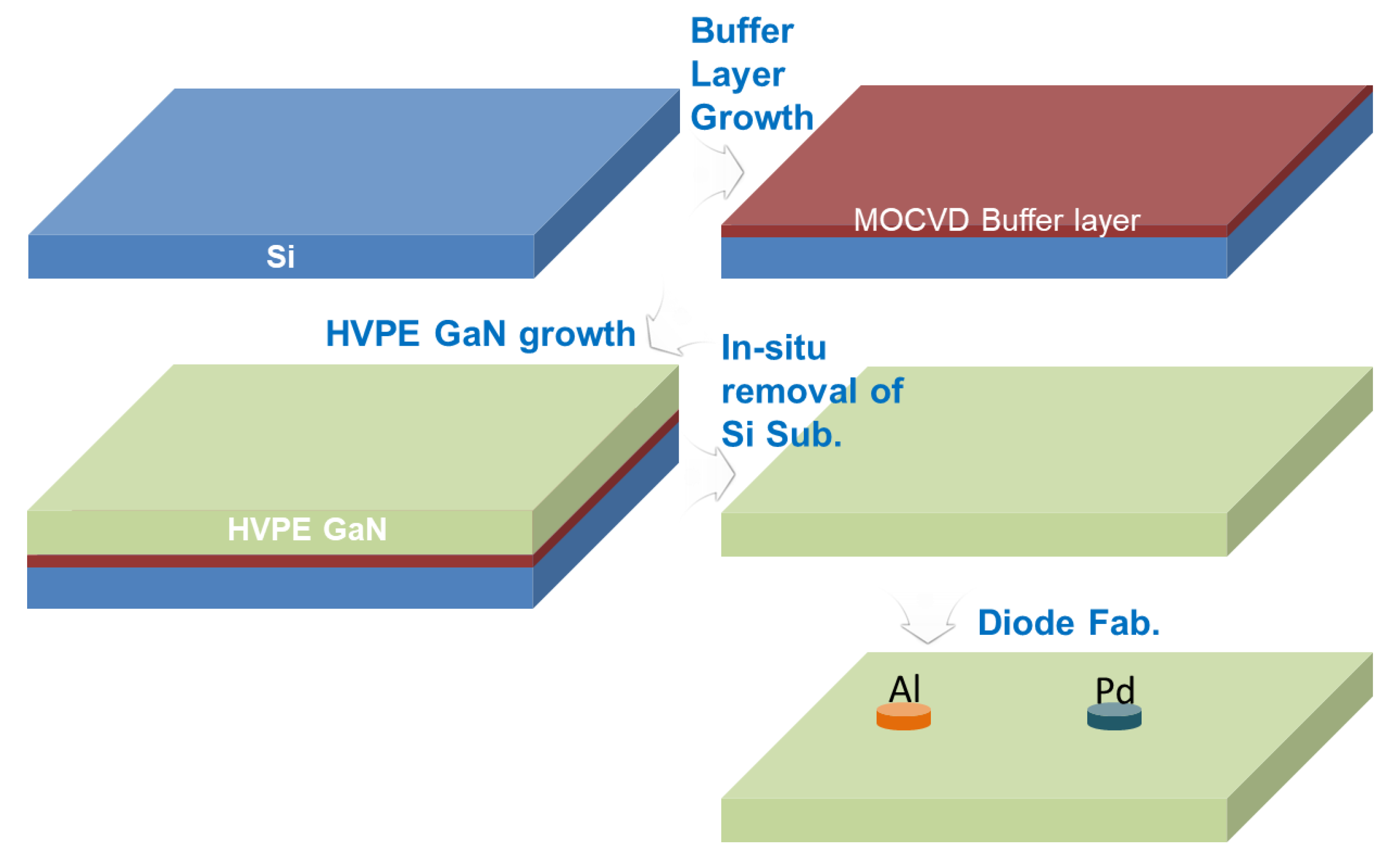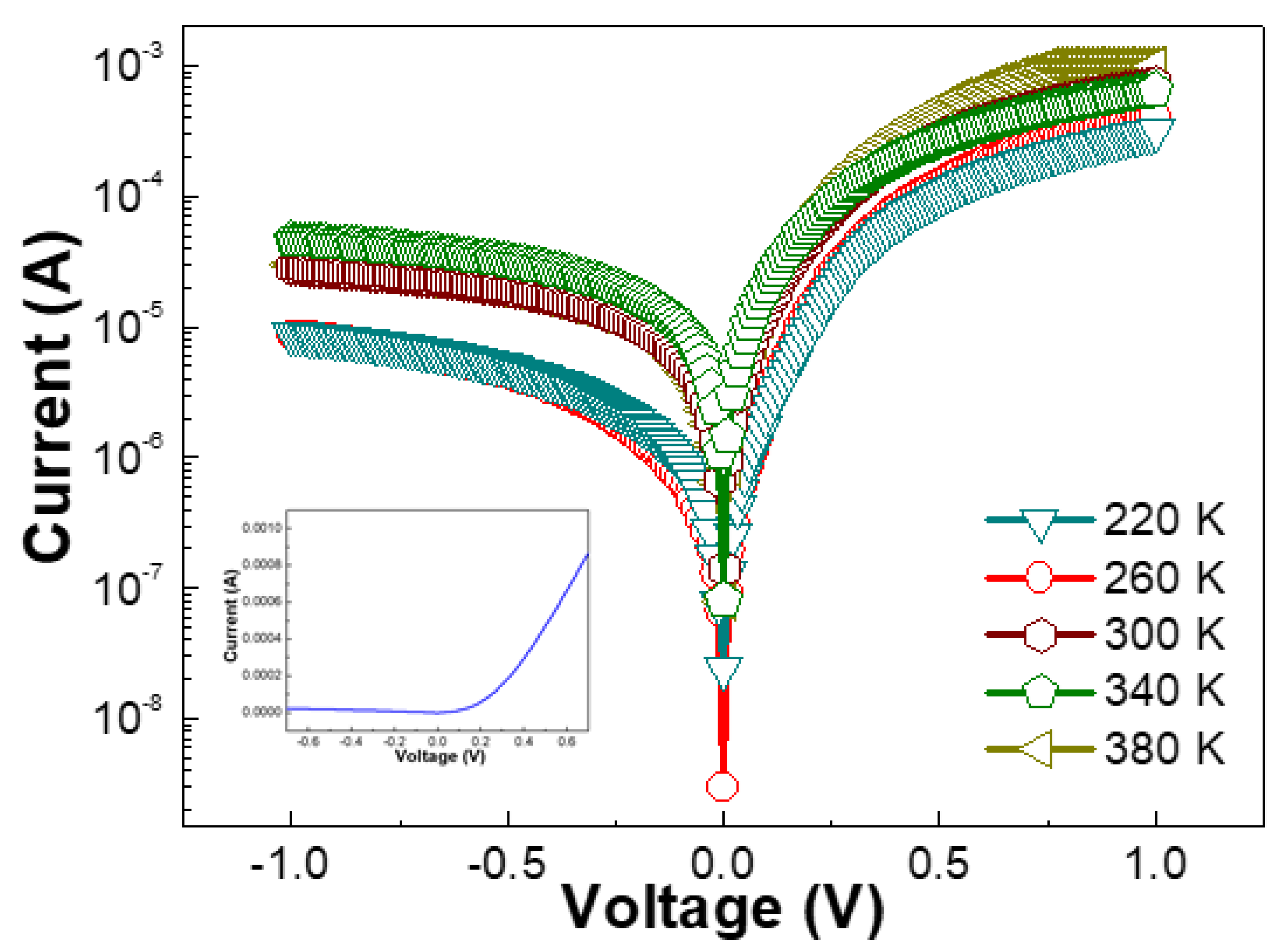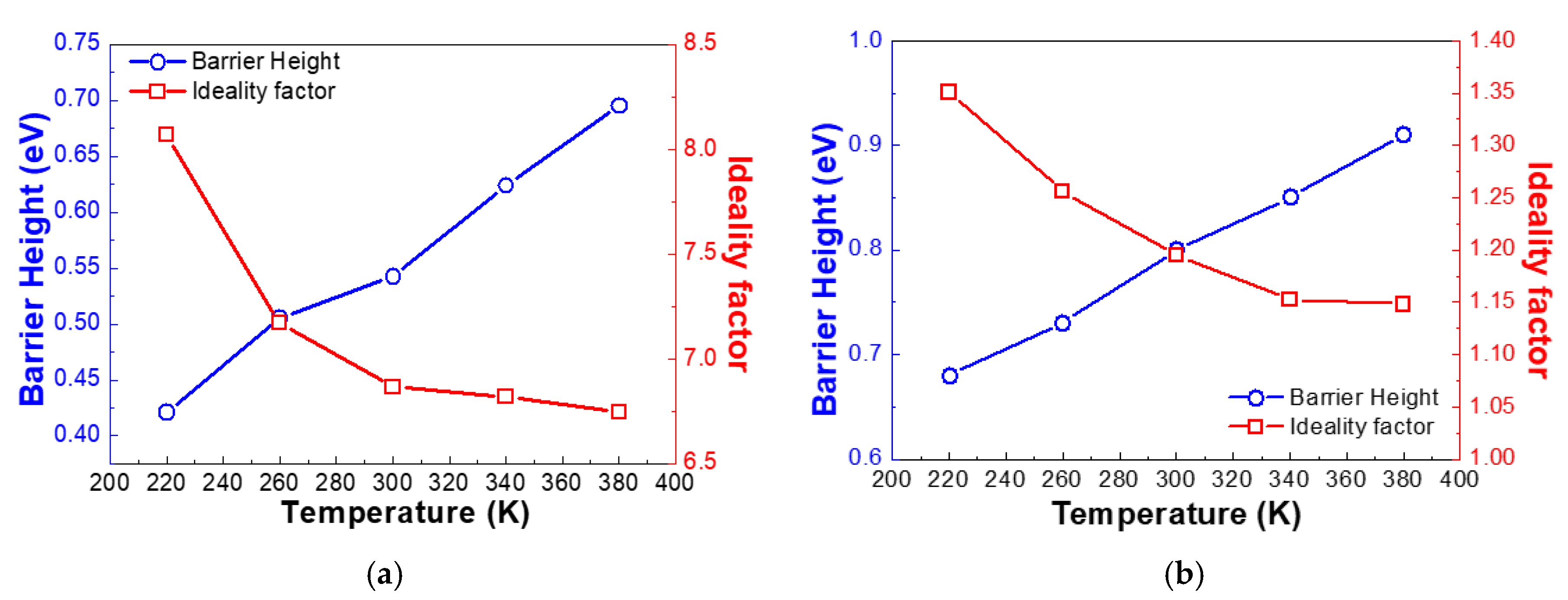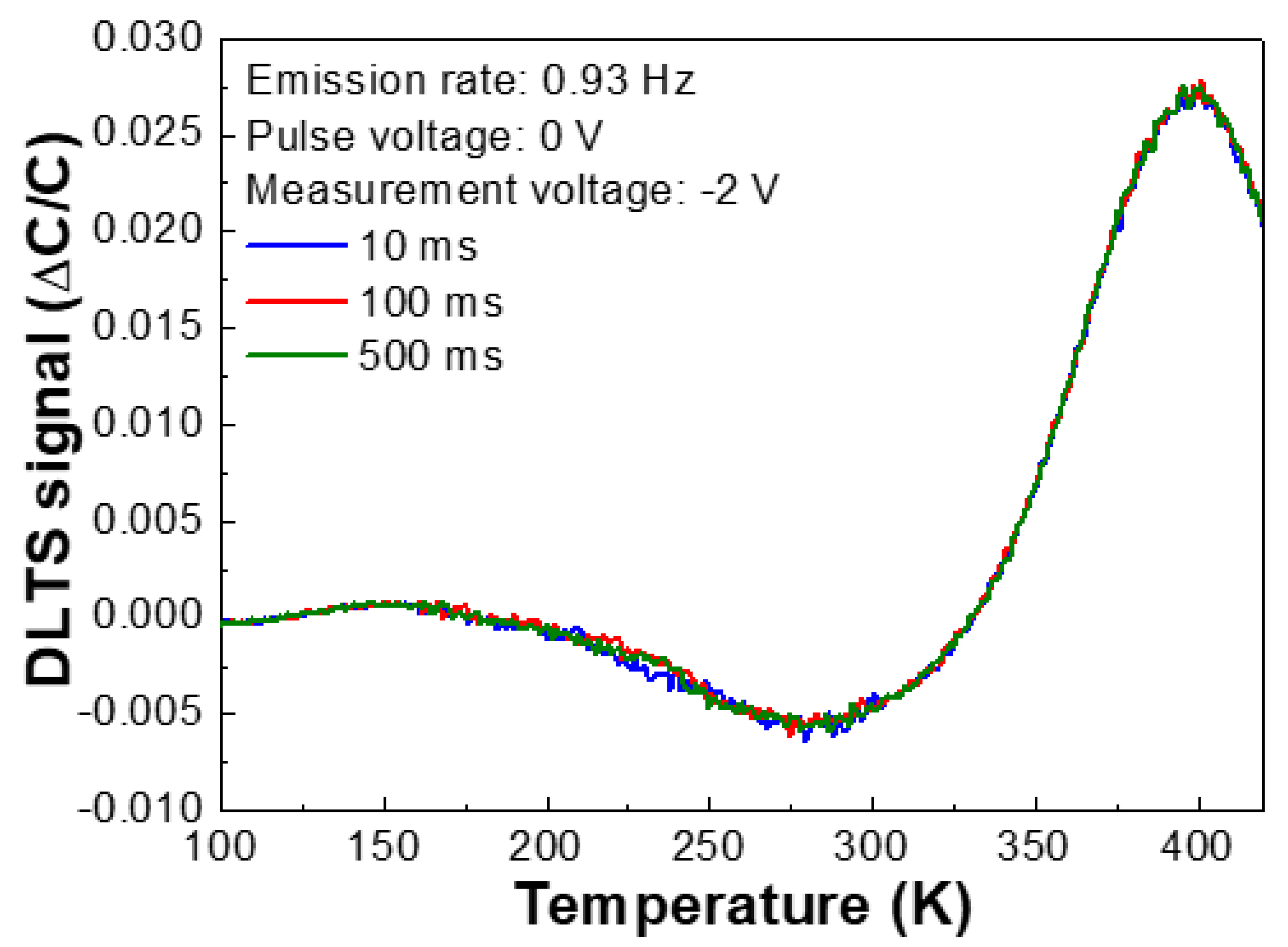Current Transport Mechanism in Palladium Schottky Contact on Si-Based Freestanding GaN
Abstract
1. Introduction
2. Materials and Methods
3. Results and Discussion
4. Conclusions
Author Contributions
Funding
Conflicts of Interest
References
- Chung, K.; Beak, H.; Tchoe, Y.; Oh, H.; Yoo, H.; Kim, M.; Yi, G.-C. Growth and characterizations of GaN micro-rods on graphene films for flexible light emitting diodes. APL Mater. 2014, 2, 092512. [Google Scholar] [CrossRef]
- Shih, H.-Y.; Shiojiri, M.; Chen, C.-H.; Yu, S.-F.; Ko, C.-T.; Yang, J.-R.; Lin, R.-M.; Chen, M.-J. Ultralow threading dislocation density in GaN epilayer on near-strain-free GaN compliant buffer layer and its applications in hetero-epitaxial LEDs. Sci. Rep. 2015, 5, 13671. [Google Scholar] [CrossRef] [PubMed]
- Jaros, A.; Hartmann, J.; Zhou, H.; Szafranski, B.; Strassburg, M.; Avramescu, A.; Waag, A.; Voss, T. Photoluminescence of planar and 3D InGaN/GaN LED structures excited with femtosecond laser pulses close to the damage threshold. Sci. Rep. 2018, 8, 11560. [Google Scholar] [CrossRef] [PubMed]
- Du Chene, J.S.; Tagliabue, G.; Welch, A.J.; Cheng, W.-H.; Atwater, H.A. Hot hole collection and photoelectrochemical CO2 reduction with plasmonic Au/p-GaN photocathodes. Nano Lett. 2018, 18, 2545–2550. [Google Scholar] [CrossRef] [PubMed]
- Jachalke, S.; Hofmann, P.; Leibiger, G.; Habel, F.S.; Mehner, E.; Leisegang, T.; Meyer, D.C.; Mikolajick, T. The pyroelectric coefficient of free standing GaN grown by HVPE. Appl. Phys. Lett. 2016, 109, 142906. [Google Scholar] [CrossRef]
- Ma, H.; He, D.; Lei, L.; Wang, S.; Chen, Y.; Wang, H. GaN crystals prepared through solid-state metathesis reaction from NaGaO2 and BN under high pressure and high temperature. J. Alloy. Compd. 2011, 509, L124–L127. [Google Scholar] [CrossRef]
- Suihkonen, S.; Pimputkar, S.; Speck, J.S.; Nakamura, S. Infrared absorption of hydrogen-related defects in ammonothermal GaN. Appl. Phys. Lett. 2016, 108, 202105. [Google Scholar] [CrossRef]
- Takeuchi, S.; Asazu, H.; Imanishi, M.; Nakamura, Y.; Imade, M.; Mori, Y.; Sakai, A. Dislocation confinement in the growth of Na flux GaN on metalorganic chemical vapor deposition-GaN. J. Appl. Phys. 2015, 118, 245306. [Google Scholar] [CrossRef]
- Li, T.; Ren, G.; Su, X.; Yao, J.; Yan, Z.; Gao, X.; Xu, K. Growth behavior of ammonothermal GaN grown on nonpolar and semipolar HVPE GaN seeds. CrystEngComm 2019. [Google Scholar] [CrossRef]
- Liu, Z.; Ren, G.; Shi, L.; Su, X.; Wang, J.; Xu, K. Effect of carbon types on the generation and morphology of GaN polycrystals grown using the Na flux method. CrystEngcomm 2015, 17, 1030–1036. [Google Scholar] [CrossRef]
- Cich, M.J.; Aldaz, R.I.; Chakraborty, A.; David, A.; Grundmann, M.J.; Tyagi, A.; Zhang, M.; Steranka, F.M.; Krames, M.R. Bulk GaN based violet light-emitting diodes with high efficiency at very high current density. Appl. Phys. Lett. 2012, 101, 223509. [Google Scholar] [CrossRef]
- Kelly, M.K.; Vaudo, R.P.; Phanse, V.M.; Görgens, L.; Ambacher, O.; Stutzmann, M. Large free-standing GaN substrates by hydride vapor phase epitaxy and laser-induced liftoff. Jpn. J. Appl. Phys. 1999, 38, L217. [Google Scholar] [CrossRef]
- Lee, M.; Yang, M.; Song, K.M.; Park, S. InGaN/GaN blue light emitting diodes using freestanding GaN extracted from a Si substrate. ACS Photonics 2018, 5, 1453–1459. [Google Scholar] [CrossRef]
- Lee, M.; Lee, H.U.; Song, K.M.; Kim, J. Significant improvement of reverse leakage current characteristics of Si-based homoepitaxial InGaN/GaN blue light emitting diodes. Sci. Rep. 2019, 9, 970. [Google Scholar] [CrossRef]
- Lee, M.; Lee, H.; Song, K.; Kim, J. Investigation of forward tunneling characteristics of InGaN/GaN blue light-emitting diodes on freestanding GaN detached from a Si substrate. Nanomaterials 2018, 8, 543. [Google Scholar] [CrossRef]
- Lee, M.; Ahn, C.W.; Vu, T.K.O.; Lee, H.U.; Kim, E.K.; Park, S. First observation of electronic trap levels in freestanding GaN crystals extracted from Si substrates by hydride vapour phase epitaxy. Sci. Rep. 2019, 9, 7128. [Google Scholar] [CrossRef]
- Zou, X.; Zhang, X.; Lu, X.; Tang, C.W.; Lau, K.M. Fully vertical GaN pin diodes using GaN-on-Si epilayers. IEEE Electron Device Lett. 2016, 37, 636–639. [Google Scholar] [CrossRef]
- Kumar, A.; Kashid, R.; Ghosh, A.; Kumar, V.; Singh, R. Enhanced thermionic emission and low 1/f noise in exfoliated graphene/GaN Schottky barrier diode. ACS Appl. Mater. Interfaces 2016, 8, 8213–8223. [Google Scholar] [CrossRef]
- Singh, R.; Sharma, P.; Khan, M.A.; Garg, V.; Awasthi, V.; Kranti, A.; Mukherjee, S. Investigation of barrier inhomogeneities and interface state density in Au/MgZnO: Ga Schottky contact. J. Phys. D Appl. Phys. 2016, 49, 445303. [Google Scholar] [CrossRef]
- Kumar, A.; Heilmann, M.; Latzel, M.; Kapoor, R.; Sharma, I.; Göbelt, M.; Christiansen, S.H.; Kumar, V.; Singh, R. Barrier inhomogeneities limited current and 1/f noise transport in GaN based nanoscale Schottky barrier diodes. Sci. Rep. 2016, 6, 27553. [Google Scholar] [CrossRef]
- Rajpalke, M.K.; Bhat, T.N.; Roul, B.; Kumar, M.; Krupanidhi, S. Current transport in nonpolar a-plane InN/GaN heterostructures Schottky junction. J. Appl. Phys. 2012, 112, 023706. [Google Scholar] [CrossRef]
- Reddeppa, M.; Park, B.-G.; Lee, S.-T.; Hai, N.H.; Kim, M.-D.; Oh, J.-E. Improved Schottky behavior of GaN nanorods using hydrogen plasma treatment. Curr. Appl. Phys. 2017, 17, 192–196. [Google Scholar] [CrossRef]
- Omotoso, E.; Meyer, W.E.; Auret, F.D.; Paradzah, A.T.; Diale, M.; Coelho, S.M.; van Rensburg, P.J. The influence of high energy electron irradiation on the Schottky barrier height and the Richardson constant of Ni/4H-SiC Schottky diodes. Mater. Sci. Semicond. Process. 2015, 39, 112–118. [Google Scholar] [CrossRef]
- Sze, S.M.; Ng, K.K. Physics of Semiconductor Devices; John Wiley & Sons: Hoboken, NJ, USA, 2006. [Google Scholar]
- Crowell, C. Richardson constant and tunneling effective mass for thermionic and thermionic-field emission in Schottky barrier diodes. Solid-State Electron. 1969, 12, 55–59. [Google Scholar] [CrossRef]
- Hacke, P.; Detchprohm, T.; Hiramatsu, K.; Sawaki, N. Schottky barrier on n-type GaN grown by hydride vapor phase epitaxy. Appl. Phys. Lett. 1993, 63, 2676–2678. [Google Scholar] [CrossRef]
- Reddy, V.R.; Reddy, N.N.K. Current transport mechanisms in Ru/Pd/n-GaN Schottky barrier diodes and deep level defect studies. Superlattices Microstruct. 2012, 52, 484–499. [Google Scholar] [CrossRef]
- Akkal, B.; Benamara, Z.; Abid, H.; Talbi, A.; Gruzza, B. Electrical characterization of Au/n-GaN Schottky diodes. Mater. Chem. Phys. 2004, 85, 27–31. [Google Scholar] [CrossRef]
- Mattila, T.; Nieminen, R.M. Point-defect complexes and broadband luminescence in GaN and AlN. Phys. Rev. B 1997, 55, 9571. [Google Scholar] [CrossRef]
- Look, D.C.; Reynolds, D.; Fang, Z.-Q.; Hemsky, J.; Sizelove, J.; Jones, R. Point defect characterization of GaN and ZnO. Mater. Sci. Eng. B 1999, 66, 30–32. [Google Scholar] [CrossRef]
- Fang, Z.-Q.; Claflin, B.; Look, D.C.; Green, D.; Vetury, R. Deep traps in AlGaN/GaN heterostructures studied by deep level transient spectroscopy: Effect of carbon concentration in GaN buffer layers. J. Appl. Phys. 2010, 108, 063706. [Google Scholar] [CrossRef]
- Cho, H.; Kim, C.; Hong, C.-H. Electron capture behaviors of deep level traps in unintentionally doped and intentionally doped n-type GaN. J. Appl. Phys. 2003, 94, 1485–1489. [Google Scholar] [CrossRef]
- Hacke, P.; Detchprohm, T.; Hiramatsu, K.; Sawaki, N.; Tadatomo, K.; Miyake, K. Analysis of deep levels in n-type GaN by transient capacitance methods. J. Appl. Phys. 1994, 76, 304–309. [Google Scholar] [CrossRef]
- Hierro, A.; Arehart, A.; Heying, B.; Hansen, M.; Speck, J.; Mishra, U.; DenBaars, S.; Ringel, S. Capture kinetics of electron traps in MBE-grown n-GaN. Phys. Status Solidi B 2001, 228, 309–313. [Google Scholar] [CrossRef]
- Pak, S.W.; Lee, D.U.; Kim, E.K.; Park, S.H.; Joo, K.; Yoon, E. Defect states of a-plane GaN grown on r-plane sapphire by controlled integration of silica nano-spheres. J. Cryst. Growth 2013, 370, 78–81. [Google Scholar] [CrossRef]
- Peta, K.R.; Park, B.-G.; Lee, S.-T.; Kim, M.-D.; Oh, J.-E.; Kim, T.-G.; Reddy, V.R. Analysis of electrical properties and deep level defects in undoped GaN Schottky barrier diode. Thin Solid Film 2013, 534, 603–608. [Google Scholar] [CrossRef]
- Duc, T.T.; Pozina, G.; Janzén, E.; Hemmingsson, C. Investigation of deep levels in bulk GaN material grown by halide vapor phase epitaxy. J. Appl. Phys. 2013, 114, 153702. [Google Scholar] [CrossRef]
- Fang, Z.; Look, D.C.; Visconti, P.; Lu, C.; Wang, D.; Morkoç, H.; Park, S.; Lee, K. Characteristics of deep traps in freestanding GaN. MRS Online Proc. Libr. Arch. 2001, 693. [Google Scholar] [CrossRef]
- Tokuda, Y.; Matuoka, Y.; Yoshida, K.; Ueda, H.; Ishiguro, O.; Soejima, N.; Kachi, T. Evaluation of dislocation-related defects in GaN using deep-level transient spectroscopy. Phys. Status Solidi C 2007, 4, 2568–2571. [Google Scholar] [CrossRef]




| Reference | Activation Energy (eV) | Capture Cross Section (cm2) | Trap Density (cm−3) |
|---|---|---|---|
| This study | 0.24 | 1.65 × 10−17 | 1.07 × 1014 |
| 1.06 | 1.76 × 10−14 | 2.19 × 1015 | |
| [37] | 0.25, 0.53, 0.65, 0.69, 1.40, 1.55 | 10−12–10−16 | ~1012–2.2 × 1015 |
| [38] | 0.25, 0.35, 0.59, 0.66, 1.0 | 6.7 × 10−14–9.0 × 10−16 | Mid-1014 |
| [39] | 0.6 | 2.0−10−17 | - |
© 2020 by the authors. Licensee MDPI, Basel, Switzerland. This article is an open access article distributed under the terms and conditions of the Creative Commons Attribution (CC BY) license (http://creativecommons.org/licenses/by/4.0/).
Share and Cite
Lee, M.; Ahn, C.W.; Vu, T.K.O.; Lee, H.U.; Jeong, Y.; Hahm, M.G.; Kim, E.K.; Park, S. Current Transport Mechanism in Palladium Schottky Contact on Si-Based Freestanding GaN. Nanomaterials 2020, 10, 297. https://doi.org/10.3390/nano10020297
Lee M, Ahn CW, Vu TKO, Lee HU, Jeong Y, Hahm MG, Kim EK, Park S. Current Transport Mechanism in Palladium Schottky Contact on Si-Based Freestanding GaN. Nanomaterials. 2020; 10(2):297. https://doi.org/10.3390/nano10020297
Chicago/Turabian StyleLee, Moonsang, Chang Wan Ahn, Thi Kim Oanh Vu, Hyun Uk Lee, Yesul Jeong, Myung Gwan Hahm, Eun Kyu Kim, and Sungsoo Park. 2020. "Current Transport Mechanism in Palladium Schottky Contact on Si-Based Freestanding GaN" Nanomaterials 10, no. 2: 297. https://doi.org/10.3390/nano10020297
APA StyleLee, M., Ahn, C. W., Vu, T. K. O., Lee, H. U., Jeong, Y., Hahm, M. G., Kim, E. K., & Park, S. (2020). Current Transport Mechanism in Palladium Schottky Contact on Si-Based Freestanding GaN. Nanomaterials, 10(2), 297. https://doi.org/10.3390/nano10020297






